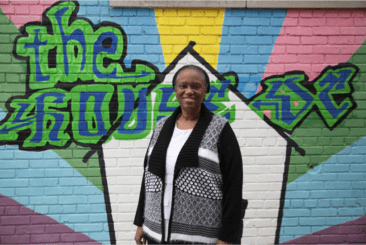The House DC offers hot meals and hope for at-risk teens in one of the District of Columbia’s most challenging neighborhoods.

The House DC after-school program has few rules and regulations. There’s little in the way of homework help or other structured programming. Every day begins with a free snack and ends with a free meal. In between, the teens who come to The House can take advantage of a variety of offerings: a recording studio, ping pong, and pool tables, a weight room, an Xbox—and an optional weekly Bible study called “life sessions.”
By providing a safe space, hot meals, community, and love, the program fosters a sense of hope. The result: fewer fights at school and higher graduation rates and college attendance than for other kids in the neighborhood. The House now serves anywhere from 20 to 70 students on weekdays, with about 100 young people coming through the doors in a school year.
Many of the teens live in precarious situations. Last summer, the student who won an award for most regular attendance at The House was shot. He survived; but this December, a 15-year-old House student was fatally shot after school. The Washington Post reported that police had no motive for why Gerald Watson was chased and killed by two masked assailants in the apartment building next door to the one in which he lived.
“You don’t know what you’re going to eat; you don’t know where you’re going to sleep; you don’t know if you’re going to get shot. You just don’t know,” said Britney Smith, 26, a former participant who now works at The House.
“You can consider [the teens] bad, but I consider them lost. And scared.”
“You don’t know what you’re going to eat; you don’t know where you’re going to sleep; you don’t know if you’re going to get shot. You just don’t know.”
Smith was one of those lost kids, homeless for periods during high school. When she came to The House, her motivation was the free, home-cooked dinner. “My only goal was to come in here and get some food and to steal some food for my brother,” she says. But a staff member noticed Smith taking extra food, and asked whether she needed another plate—and then brought one over, wrapped to go.
Smith nearly dropped out of high school her senior year, after she got pregnant. Her school uniform no longer fit, and when she went to school out of uniform, she was sent home. “I was this close to, ‘All right, I’m not coming back,’” she says, but The House gave her a larger uniform along with lunch money and an air mattress to sleep on. With support from The House, she made it to graduation, walking across the stage in 2010 with her month-old baby in the audience. She started volunteering at The House the next year and joined the staff in 2015.
Smith understands the challenges students face. Anacostia High School, the nearby public school, had a graduation rate last year of 50 percent and has seen six principals in the last decade. The ZIP code that includes the high school and the youth center has an unemployment rate over 15 percent, a median household income under $35,000, and a high school dropout rate around 15 percent. More than a third of residents live below the poverty line, including half of all children. As of mid-December 2018, the city council district that covers the area accounted for 42 percent of the year’s homicides despite holding just 12 percent of the city’s population.
Many of The House participants are banned from the school’s extracurricular activities because of grades, attendance or discipline issues. Being able to go to The House after school makes a difference.
“A lot of these kids are essentially raising themselves, and sometimes are raising their siblings as well,” Anacostia High School resource officer Charles Jones told researchers from Baylor University in a recently published case study on the nonprofit.

“They come to The House for security and comfort,” he said, “because the staff genuinely care, and they can see that and feel that. As I overheard one student say on his way to The House one day: ‘I’m going to the safe house, not the stress house.’”
Anthony Manley, a security officer at the school, told the researchers about a similar conversation he had overheard. At the end of a school day, a girl had been talking with friends who were “clearly up to no good” and inviting the girl to join them.
“‘Nah, I’m not going with you. I’m going to The House,’” Manley heard her say. “In that one simple exchange, I really understood the importance of The House DC for the kids in the neighborhood simply as a place to go.”
Given the kinds of students The House wants to reach, President and CEO La Wonda Bornstein says it’s important that the program doesn’t impose many rules. There’s usually a staff member working security at the entrance, but kids are free to come and go as they please. Bornstein tells visitors to expect some profanity and the smell of marijuana.
Dequwan Smith, another 26-year-old alum-turned-employee—who is married to Britney Smith—said of the low-rule environment: “It’s a very delicate procedure to get to kids on their level and inside of what they’re feeling. You can’t come at them like a doctor; you can’t come at them like a teacher. You’ve got to come at them like a person—like they’re family, more so. We don’t want to push them away instantly.”
“It’s a very delicate procedure to get to kids on their level and inside of what they’re feeling. You can’t come at them like a doctor; you can’t come at them like a teacher. You’ve got to come at them like a person—like they’re family.”
Bornstein joined The House in 2001, initially as a volunteer. She brought a business background from her work in corporate recruitment. As an African-American whose family had helped integrate several evangelical Christian schools in the Washington area, she had experience building bridges between racial communities.
Though it began and still operates as a Christian outreach program, The House avoids hitting kids over the head with a religious message, Bornstein said.
“Even though we are a faith-based organization, we’ll have secular music playing,” Bornstein said. “When you walk into our organization, you won’t see Bible verses on the wall, because the type of people that we’re targeting just wouldn’t come to a religious organization like that.”
Despite the challenges its students face, The House sees a 96 percent high school graduation rate among its regular participants, and higher-than-average college enrollment rates, according to the Baylor University case study. The Anacostia High School resource officer told researchers that he sees the youth center’s members get in fights less often than other students.
The House aims to plant seeds in these at-risk youth. Seeds of professional passion, of self-sufficiency, of commitment to family, of faith. Seeds that take years to grow and bear fruit, nurtured by long-term relationships with caring adults who understand their world. Seeds scattered on soil that other organizations might deem too rocky.
This excerpt was taken from a longer article, first published in Faith and Leadership. It appears here with permission. Read the full article here.


